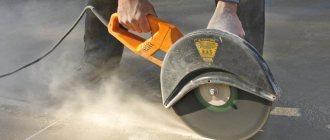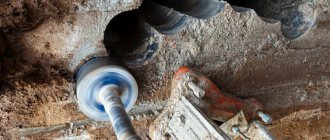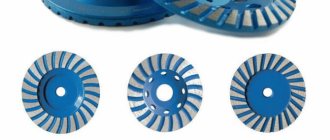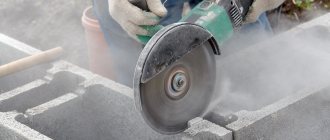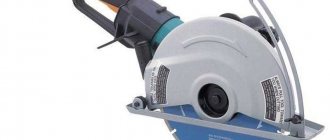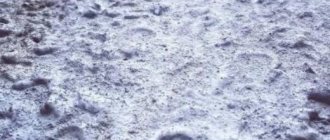When performing work on the construction of the basement floor of a 2-story building, it became necessary to cut concrete and reinforced concrete structures. The first thought that arose was about how to cut concrete. I tried a grinder with specialized diamond wheels. As a result, the tool worked as expected and coped with the task. See in the review how I chose the tool and equipment for it, what main features I took into account during cutting.
Source 1beton.info
How to cut concrete with a grinder
(No one has voted yet) Loading…
Increasing door and window openings can cause a lot of trouble. For many homeowners, carrying out this work becomes a difficult task.
Find out here how to quickly and without unnecessary dust cut the necessary hole in concrete.
We cut concrete ourselves
Professional teams that provide cutting services for reinforced concrete products have equipment in their arsenal that allows them to carry out all the work quickly and with a minimum amount of dust. You will have to call specialists when it is necessary to cope with a large volume of work. Otherwise, you can try cutting the hole yourself.
For this you will need:
- 4 or 5 inch grinder (disc diameter 100 mm or 125 mm);
- a diamond disc of the appropriate size, it can be regular segmented or TURBO.
When choosing diamond blades, you should pay attention not only to the price; it is lower than that of conventional cutting elements. But also in terms of productivity, this figure is significantly higher for turbocharged diamond cutting discs.
Ways to reduce dust emissions
For many craftsmen, dust becomes a significant obstacle when cutting concrete structures. It not only makes breathing difficult, but also significantly reduces visibility, which can affect the accuracy of the work being done.
Very often, craftsmen attach a vacuum cleaner to an angle grinder. While the coal grinder is operating, the vacuum cleaner that is turned on collects dust, preventing it from flying in different directions.
There is another way that can reduce dust emissions. It's called wet cutting. The bottom line is that water is supplied to the disc, which wets the concrete and prevents dust from forming. When using water, you must use special discs for wet diamond cutting.
Maintaining safety when working with an angle grinder
Cutting holes in reinforced concrete is invariably accompanied by a large amount of dust and a high noise level.
Therefore, it is necessary to use personal protective equipment:
- a mask that will protect your eyes from dust and debris;
- respirator. Provides free breathing in a dust cloud;
- special anti-noise headphones. They are able to protect against strong industrial noise, but make it possible to hear the interlocutor’s speech and other quiet sounds;
- protective clothing and gloves. Their use will help protect the skin from injury from large concrete particles.
Compliance with the necessary safety measures will allow work to be carried out even with a large emission of dust.
In the video we watch how to cut concrete with a grinder and a hammer drill:
Source No. 1: https://rezka-betona.kiev.ua/
Tweet
glavspec.ru
It is important to know
Modern manufacturers offer various models of equipment, so it will not be difficult to find a specific model of equipment in the regions (also companies or specialists who will quickly and efficiently do the job). But you need to understand certain aspects.
Things to keep in mind when cutting concrete:
- Wall saws are not used in high-rise panel buildings due to the risk of flooding the lower floors with water. Also, the machine is not suitable for working in confined spaces, making small volumes of cutting as needed.
- To reduce noise, you can cut the holes in parts (at least 6 parts last). The cost of work in this case increases and depends on the number of pieces cut.
- All openings/openings in load-bearing structures are made only by certified companies and in strict accordance with the rules.
- Legalization of hatches/openings in load-bearing walls requires an appeal to municipal authorities with the provision of a full package of documents.
Cutting concrete without dust. This is not an easy task and can only be partially achieved. It is very difficult to get rid of dust one hundred percent, but its amount can be significantly reduced through the correct choice of equipment and attachments, cutting method, as well as the use of a construction vacuum cleaner and the creation of special dust collection devices.
Grinder cutting wood, brick, glass, paving slabs, concrete and other materials
A modern grinder is a universal tool designed to perform various jobs. With its help you can cut various materials: metal, wood, plywood, natural stone, foam block, cinder block, paving and tiles, brick, laminate, concrete, ordinary and organic glass. At the same time, sheets, blocks, pipes are cut, grooves are made. An angle grinder is also used to grind and polish surfaces. When performing work, it is important to know how to cut correctly with a grinder - not only the quality of the result depends on it, but also, to a large extent, personal safety. When working with different materials, you must use only wheels designed specifically for them.
Cutting wood, plywood, laminate using an angle grinder
To cut wood, plywood or laminate with an angle grinder, use appropriate discs. They are designed specifically for high speed operation. But the best suitable circles are quite rare on sale.
Wood cutting
A special wood blade has side teeth that increase the size of the cut. In any case, you need to cut wood carefully. The thickness of the boards should not exceed 4 cm.
Cutting wood with a grinder is a very unsafe activity, during which you can easily get injured. However, it is strictly forbidden to use circular saw blades, because they are designed to operate at speeds that do not exceed 3000 rpm. If jamming occurs, such circles may collapse. This is due to the fact that they are made of hard, but relatively brittle steel. Also, do not use attachments with large teeth, because it increases the likelihood that the teeth will catch and the wheel will jam. At the same time, the likelihood of the power tool being torn out of your hands increases many times over.
If, despite the increased danger, you decide to cut boards with an angle grinder, then you must adhere to the following recommendations.
- If it is possible to adjust the number of disk revolutions, it is recommended to set the minimum possible number.
- While sawing, the tool must be kept in one (working) plane, because distortions can easily cause traumatic consequences.
- The locking button should not be pressed after turning on the power tool, since it is more difficult to turn it off if necessary.
- The wood to be sawn must be dry; undried (raw) lumber should not be cut.
- With relatively long boards, it is better to work with a partner.
- Safety regulations must be followed.
- The best option is to work with boards that have the same thickness.
- The material being cut must not contain foreign matter, such as nails, screws, bolts, or wire.
To best secure the work process, the grinder should be used as a circular saw, fixed in a stationary (fixed) position. In this case, the tool is fixed on a frame having guides. During sawing, the working material is fed in the same way as on a circular saw.
The main disadvantage of this method of cutting lumber is the relative complexity of its implementation from a technical point of view.
Sawing laminate and plywood
To cut laminate, use circles for metal, concrete, intended for cutting ceramic tiles, as well as fine-toothed ones for wood. When working, it is recommended to adhere to the following rules:
- The cut should be made from the front part of the lamellas so as not to leave chips at the cutting site;
- due to the formation of a large amount of dust and the unpleasant smell of burning material, you need to work in a well-ventilated area;
- To obtain an even cut, the lamella must be motionless.
Wood discs are used to cut plywood. The cut is made along a pre-marked line. In this case, care should be taken to ensure that the circle before the end is not jammed by the sawn fragment of the sheet.
Selection of quarters in the board
Using an angle grinder, you can select a quarter in a board, but this operation requires experience in this type of work and good tool skills. The best option would be to secure the grinder in a stationary, motionless position. Then the work will be performed as on a circular machine.
When manually removing a quarter using a grinder, you should securely fasten the wooden workpiece so that there is no movement. This method is mainly suitable only when working with thick boards, because it is quite problematic to control the cutting depth. At the same time, you can easily cut through the wood in thin places.
The quarter is chosen from the board as follows:
- mark the lumber with a pencil or marker;
- perform a cut from the edge (end) of the board, slowly, carefully moving the tool along the marked line;
- cut the lumber at a different mark.
You can also select quarters with a grinder using a special cutter. It is better not to use homemade attachments for personal safety reasons. The method using a cutter allows you to make grooves in relatively small parts.
Both considered options are not suitable for significant volumes of work, since the process of removing a quarter with an angle grinder is relatively slow.
It is better to perform all operations with an experienced partner in order to get the necessary help if necessary.
Brick cutting
Brick is a common material in construction. It often needs to be adjusted to size when carrying out repair work at home. At the same time, cutting bricks with a grinder is a very common operation. To carry it out, you will need, in addition to working power tools with cutting discs, the following devices:
- construction pencil or chalk;
- ruler and square.
The entire process of cutting brick blocks is accompanied by significant dust formation, so care should be taken to protect the respiratory system and eyes from dust. To do this, you should use goggles and a respirator, or a solid mask. Hands must be protected with gloves.
To work virtually dust-free, you need to regularly water the cut area.
The cutting process itself consists of several stages:
- drawing marking lines with chalk or pencil using a ruler or square;
- cutting a brick, in which the circle must pass near the marked line to ensure the required size of the block fragment.
It is recommended to place a board under the brick to be sawed to make working more convenient and not damage the flooring. When cutting a brick block, you do not need to apply pressure to the power tool. A little effort is enough. When work is carried out using circles of insufficient diameter for complete sawing, the cut is made along the marked perimeter. The excess is beaten off with a hammer and then polished.
Labor efficiency and the quality of the final result can be increased by using a special bed. It allows you to securely secure the grinder and the brick block. At the same time, it becomes possible to saw the brick not only lengthwise or crosswise, but also at various angles. This installation is shown in the following photo.
To saw a brick straight away without turning it over, you should use circles with a disk diameter of 230 mm. It is easier to process cut areas if the nozzle size is 125 mm. If you cut blocks with such a relatively small disk, the quality of the result will largely be determined by the skill of the carver. The time it takes to complete the work will also increase and labor productivity will decrease.
Discs for sawing bricks
Cutting wheels for cutting brick blocks should be chosen correctly. Suitable discs fall into two categories:
The main advantage of the first group of circles is their relatively low cost. But abrasive attachments have to be replaced frequently due to their failure.
Abrasive discs can break during work or crack or become deformed - this is the danger of their use.
Diamond wheels are considered the best option for cutting brick blocks. They are made from durable steel grades. Such nozzles are characterized by a long service life. They are safer than abrasive counterparts. There are several types of diamond blades:
- wheels with a continuous diamond edge;
- segment nozzles;
- circles with a cutting edge with teeth.
Products of the first group are characterized by a low price. But when used, they wear out faster and heat up more than other analogues. Segmented discs are characterized by better removal of brick particles from the cut. They also heat up slowly. This variety is a good option when cutting is done dry.
A group of nozzles with a serrated edge has the best strength characteristics among other varieties. They are used for both wet and dry cutting methods. They have a long service life.
Features of cutting glass and plexiglass with a grinder
Glass is a transparent, durable, but relatively fragile material. It has good temperature resistance. To process it, you need to use special tools. At home, cutting glass can be done with an ordinary grinder, and the work progresses quite quickly.
To cut glass with a grinder, circles for concrete or granite are used as working attachments. While sawing, it is necessary to constantly pour cold water over the material at the cutting site. This is due to the fact that this zone heats up very much. High temperatures lead to faster disc wear. Cooling prevents this and also improves cutting quality.
Various types of glass can be cut using this method:
- bottled;
- ordinary;
- borosilicate;
- crystal.
Organic glass (plexiglass) differs in its properties from ordinary glass. It is a durable yet lightweight material that comes in a variety of colors. It has received various practical applications. In this case, it is often necessary to cut fragments of the required size from a whole sheet. Using an angle grinder to cut organic glass is one of the options suitable for home use.
As a working attachment for cutting plexiglass, you should use thin (no more than 1 mm) circles, which are used for sawing ordinary glass.
Cutting plexiglass is also accompanied by significant heating of the cut zone. As a result, smoke may appear and the edges of the material may melt. In this case, molten particles will scatter to the sides. When they come into contact with the skin, in some cases they lead to burns. To avoid these phenomena, it is necessary to promptly cool the area of contact between the circle and the plexiglass.
Recommendations for sawing paving slabs and curb stones
Paving slabs are a popular material that allows you to beautifully and tastefully arrange paths in the yard or garden. In addition to its attractive appearance, the material is distinguished by its strength, durability, and wide range. On the sides of the paths, in most cases, curb stones will be laid, which in its characteristics is similar to the sidewalk material.
Often when laying paths, tiles and borders have to be cut to the required size. For these purposes, various tools are used, one of which is a grinder. To effectively perform sawing, it is recommended to use this power tool with a circle with a diameter of more than 230 mm and a power value equal to or exceeding 2 kW. All work is done using a diamond disc.
The actual cutting of paving slabs and curb stones with an angle grinder is carried out similarly to sawing bricks.
- First, size markings are applied to the surface of the materials being cut using a marker or chalk.
- Check the accuracy of the applied marking lines by applying tiles or borders to the installation site.
- If the size and shape match, the building material is cut without strong pressure on the power tool used.
If the sections contain defects after cutting, they are eliminated using suitable tools (for example, a hacksaw, chisel, file). The circle of the working tool should rotate so that the dust flies in the opposite direction from the worker. At the same time, he must hold the working power tool with both hands, being behind or to the side of it.
The quality of the result and the number of tile cuts depend on the accuracy of the initial marking.
The tiles cut into fragments of the required sizes should be set aside separately so that dust does not fall on them. For ease of subsequent installation, you can number the pieces. The material that has not yet been cut should be covered from dust, because then removing it from the surface of the tile is quite problematic.
Sawing concrete without dust
At a construction site and during home renovations, you often have to cut concrete with a grinder. This very dusty procedure cannot be avoided, especially during the installation of hidden wiring. To get the job done, the tool is equipped with solid or segmented diamond discs of various diameters. In this case, the size of the circles depends both on the model of power tool used and on the required cutting depth.
To cut a small non-reinforced concrete block without dust or make a groove, proceed as follows:
- marking lines are applied along the working surface with a construction pencil or marker;
- The marked area with the nearby area is moistened with water using a spray bottle or brush (even a rag), which is then periodically watered over the furrow being cut;
- saw concrete, regularly removing the disc and cooling it with water.
Cutting concrete using the wet method discussed above will not completely eliminate dust. This requires constant irrigation.
To saw concrete without creating dust, some craftsmen use a special homemade casing, which is practically airtight. Dust removal is provided by a vacuum cleaner connected for this purpose.
When cutting brick, glass, concrete, wood, plywood and other materials considered, it is necessary to use personal protective equipment: goggles, a respirator or mask, and headphones. Clothes and shoes should also be appropriate.
The angle grinder in use must be in good working order. High-quality cutting wheels should be used for sawing, free from defects. The discs and the power tool itself must be inspected before performing work. You need to perform sawing in a comfortable, stable body position.
It is prohibited to use drugs or alcohol while working. General health should also be normal. The grinder should be kept under control at all times, because very serious injury can occur. Moreover, the more powerful the device, the more attentive, careful, and careful you need to handle it.
tehnika.expert
Rules of use and care
By following these simple rules, you will keep your assistant in working condition for a long time, and also protect your health:
- Only plug and unplug the power cord when the instrument is unplugged.
- Be sure to wear safety shoes, clothing and eyewear. It is advisable to protect the respiratory system as well. The dust generated during work is extremely harmful to health.
- When changing the width, carefully secure the spacer washers.
- When gating, hold the wall chaser with both hands and at a safe distance from you.
- After 2-3 minutes of grooving, remove the tool from the groove and let the engine run for 15 seconds without load. This will cool it down.
- Don't squeeze everything out of the tool. Stick to a medium load.
- Do not work in damp areas or on wet surfaces.
- After work, wipe the wall chaser with a slightly damp cloth, then dry it, put it in a briefcase or box and store it in a dry, warm place out of reach of children.
Cutting concrete with a grinder: features of execution
Using a grinder when cutting concrete
Today it is difficult to imagine the work of mechanics or builders, repairmen and other similar professions without a grinder. It is actively used when cutting, trimming and grinding various materials.
As the number of attachments increases, its functions become more diverse. The article suggests getting to know how concrete is cut with a grinder and its features.
Features of working with an angle grinder
A grinder for cutting concrete is an indispensable tool, but it can also cause injury. This requires following operating rules when working with equipment.
These include:
- Work should only be carried out when sober and in good health;
- Before starting work, it is recommended to prepare the following devices and protective equipment:
- Face mask or goggles to prevent sparks from getting into your face and especially your eyes;
- Vacuum cleaner or respirator;
- Gloves, preferably thick ones or mittens made of genuine leather;
- Protective clothing covering all parts of the body;
- Nozzles that the equipment instructions allow you to use;
- Headphones.
- A casing that is installed between the tool and the person.
All these items will protect the worker when cutting concrete.
Equipment selection
Correctly selected equipment is the key to high-quality and long-term operation of the tool. When purchasing it, you need to pay attention to such basic parameters as: power and diameter of the cutting wheel.
Tip: Buyers are often afraid to purchase high-power models. But this is absolutely wrong! It should be borne in mind that the disks of a machine with low power may jam - the device does not have enough strength to pull it out.
For beginners, you should purchase a tool with the following characteristics:
- Power within 900 - 1000 W;
- Spindle speed approximately 10,000 rpm;
- Concrete disc on a grinder with a diameter of 125 mm.
Equipment with such technical characteristics is quite capable of sawing iron. If the technical characteristics of the selected model are suitable, but it is inconvenient to use during work, you should give preference to another option.
Types of Concrete Cutting Tools
Diamond wheels are used for cutting concrete; their main dimensions are:
- Outer diameter of discs, within 100 – 600 mm;
- Thickness, within 0.4 – 3.5 mm;
- The diameter of the mounting hole is more than 15 mm, the optimal diameter is 22.23 mm.
Diamond wheels also differ in other respects.
These include:
- Quality of diamonds on the disc;
- The material of the discs themselves;
- Soldering method;
- Form;
- Purpose.
The last two characteristics are the main ones when classifying a tool.
The table shows diamond blades with different working edge configurations:
| Type of working edge | Peculiarities |
| A distinctive feature of the tool is the presence of radial slots along the perimeter of the circle. In this case, the number of sectors when choosing a disk depends on the expected loads on it and its purpose. This design allows you to correctly distribute stress, naturally remove heat and redirect concrete particles away from the working surface of the tool. According to their characteristics, segmented wheels are best used for rough dry cutting. Diamond sputtering is performed on each segment, but most often without a binder alloy. This limits the use of discs when processing reinforced structures. | |
| Their edge is without breaks, solid, and abrasive coating is applied along its entire diameter. For better distribution of radial load there are special holes. It is recommended to use such circles to obtain a thin cut in reinforced concrete. The characteristics of the tool are better suited for installation on stationary equipment, with a continuous supply of cooling liquid. | |
| Such circles have a solid, wavy edge and are distinguished by universal characteristics. Their price is the highest. Through the grooves, dust is removed from the working surface, which receives natural cooling during cutting. A solid edge increases the strength of the tool, which makes it possible to cut reinforcement or very hard fillers in a reinforced concrete layer, regardless of its density. |
According to the spraying technology, circles are distinguished:
- Soldered with silver solder, they are used only for wet processing of concrete surfaces;
- With laser welding. These are the strongest and most durable blades that can withstand dry cutting. Such a diamond disc for concrete for an angle grinder is most often used for cutting reinforced concrete;
- Coated with special compounds, which are then exposed to high temperatures. These are universal discs with average characteristics.
The wheels also differ in the degree of spray concentration, which for high-quality tools reaches more than 30%, and the abrasive crumb is distributed throughout the entire volume of the teeth and grooves. With this design, the service life of the wheel increases significantly; when it is ground down, new layers are opened for cutting the material.
Tip: When choosing a circle for cutting concrete, you should take into account all of the above characteristics of the tool.
Silver Brazed Diamond Blade Diamond Utility Wheel
Determining the type of concrete
Before you start cutting concrete with a grinder, you need to determine its type. The choice of the type of diamond blade depends on this.
For example:
- With a cutting depth of about 100 mm and deeper, a metal grid or reinforcement cage can be placed. There are special disks for these purposes;
- It is necessary to take into account the change in the structure of the material over time. Fresh concrete is more abrasive, while old concrete has greater hardness. Because of this, diamond wheels for fresh and old materials must be different;
- There are different concrete reinforcement schemes;
Classification of concrete by density, type of binder filler and purpose
- If possible, it is worth studying the structure of the material in more detail; this will allow you to purchase the most suitable cutting wheel. Materials such as basalt or quartz will quickly dull the edges of the tool. In this case, the diamond segments are chosen to be bound with a soft material, and new diamonds will “open up” faster;
- The cutting speed is affected by the size of the filler - the larger it is, the slower the work will be.
Features of cutting with a grinder
After choosing the equipment and the circle for it, before cutting concrete with a grinder, you need to familiarize yourself with the recommendations for carrying out the work:
- The tool must be held with both hands. In this case, if a reverse strike occurs, it can be held, which will minimize the displacement of the cutting line;
- Work should be carried out only on a flat surface so that the person’s balance is maintained;
- The power cord should be located on the opposite side of the drive to prevent accidental damage to it. A cut cord can cause a shock wave from the unit and a short circuit in the electrical network;
- The tool must be held firmly in your hands until it stops completely;
- When changing the place of sawing, the grinder must be turned off so as not to accidentally touch surrounding objects;
- When there is a power outage, be sure to unplug the equipment from the network. This will prevent it from turning on when electricity is supplied without operator control.
Tip: During operation, the discs become very hot, so after turning off the grinder, you should not touch it until it cools completely.
Working with brickwork
Cutting concrete along a line
After the grinder for concrete has been prepared, work can begin.
For this:
- The cutting line is outlined. At the same time, it is advisable to fasten wooden blocks along the line, which will make the cut line more even;
- The grinder is turned on and a cut is made with a depth of approximately 5 - 10 mm;
- The bars are removed;
- A cut is made to the required depth. If the cut is made dry, the procedure should be stopped periodically to allow the instrument to cool.
Carrying out preliminary marking work
How to correctly cut concrete with a grinder, the video shows in all the details. The process is best performed with the tool cooled.
For this:
- An ordinary spray bottle sprays water directly onto the furrow to reduce the amount of dust;
- Water is sprayed directly onto the disk, in the absence of a nearby power source. This will reduce the heating of diamond blades and extend their service life;
- If it is not possible to spray liquid onto the disc, cooling can be done with air. Periodically, the circle should be removed from the cut and given the opportunity to work in the air.
Working with a grinder with manual cooling of the tool
If you have questions about cutting concrete, if you want to know how to polish concrete with a grinder and other details on using similar equipment, please see the video in this article.
Making a casing for a vacuum cleaner
Angle grinder equipment, which has a built-in vacuum cleaner, helps to get rid of small particles of material formed when cutting with an angle grinder. But if you don’t have one, you can make the device yourself. The photo shows a protective cover on the grinder disk, made by yourself.
To make a convenient nozzle you will need:
- A simple plastic canister;
- Construction cutter;
- A container of suitable size, with a neck diameter suitable for the vacuum cleaner hose.
Product manufacturing procedure:
- Mounting holes are cut on both sides of the canister; they are needed to easily change the direction of rotation of the disk;
- A slot is made for a circle of suitable size;
- A hole is cut to fix the grinder disc;
- The hose is connected to the neck of the canister through an adapter ring with a clamp;
- The grinder is placed in the casing, and all elements are connected;
- Excess holes are covered with lids.
Cutting concrete with a grinder is not difficult. The most important thing is to choose the right diamond blade and strictly follow the certain rules given above. In addition, safety precautions must be observed - working with power tools requires great care.
beton-house.com
Tools
So, to perform this operation, first of all you will need an angle grinder for concrete, which is popularly called an angle grinder. As an attachment, you need to use a special diamond wheel for concrete for an angle grinder.
It must be said that they exist in several types:
- Segmented;
- Turbo diamond;
- Turbo diamond with wave body.
Segmented circles are not the best solution, since certain problems may arise when cutting with them, which is associated with their segmented edges. But the advantage is their low price compared to other types of attachments.
Turbo diamond blades with a wave body will allow you to perform cutting with the highest load, for example, when it is necessary to cut reinforced concrete. Of course, this type of attachment is the most expensive.
Segmented Diamond Wheel
Advice! Cutting reinforced concrete with diamond wheels is first performed to a depth of about one centimeter. If no problems are found with the grinder or the disc, then the procedure is continued. Each subsequent cut should be no deeper than one and a half centimeters.
Turbo diamond wheel
Reviews
Fiolent B3-40 F0054
You should buy Fiolent B3-40 F0054 if you want to support a domestic manufacturer.
Such a purchase will be beneficial if the tool is required for one-time work and not on an ongoing basis. In this case, you simply will not have time to notice the shortcomings of this model.
It has enough advantages: at the everyday level, the wall chaser copes quite well with any surface - be it gypsum plaster or reinforced concrete. However, the width of the groove will have to be determined manually.
Main advantages:
- Availability of a two-position additional handle.
- The presence of a pipe for connecting a vacuum cleaner.
- Light weight.
- High spindle speed (9000 rpm).
Cons: Inability to adjust groove width.
BOSCH GNF 35 CA Professional
Professional wall chaser for working on brick and concrete. The motor power of 1400 W is enough to groove channels with a depth of 35 mm and a width from 3 to 39 mm.
Like other professional models, the tool provides the ability to adjust the width and depth of the groove.
The patented dust protection system of the mechanism significantly extends the service life of the wall chaser.
Main advantages:
- a variety of protective equipment;
- possibility of connecting a vacuum cleaner;
- adjustment of groove width and cutting depth;
- high power.
Cons: High price.
AEG MFE 1500
The AEG MFE 1500 wall chaser is designed for regular professional work. It works best when chipping bricks. Can also be used for work on concrete and stone.
The device has a thermal overload fuse, a locking spindle and other safety features.
Main advantages:
- Adjustable cutting depth.
- Adjustable groove width.
- High reliability.
- Simple controls.
- Built-in cooling fan.
- Possibility of connecting a vacuum cleaner.
- High power.
Cons: High price.
